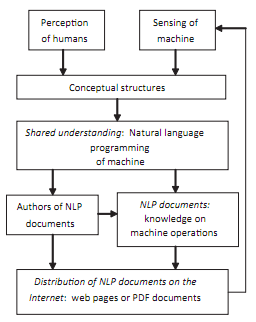Autonomous machines, networks, and robots will self-improve in the future by publishing their own upgrade suggestions
July 18, 2011

Block diagram of knowledge generation, sharing between humans and machines, and its distribution via publications (credit: S.M. Veres)
The best way for autonomous machines, networks, and robots to improve in the future will be for them to publish their own upgrade suggestions on the Internet, says Sandor Veres of the University of Southampton’s Faculty of Engineering and the Environment.
This leap to increased autonomy will be facilitated by machines and humans publishing information in a common language online. This can be achieved by the following technical features:
- Some modelling of a changing environment;
- Learning various skills in feedback interaction with the environment;
- Symbolic recognition of events and actions to perform logic-based computation;
- Ability to explain reasons of its own actions to humans; and
- Efficient transfer of rules, goals, values, and skills from human users to the autonomous system.
The last three of these five desirable technical features might be achieved with the natural language programming (NLP) sEnglish (“system English”) system, which enables shared understanding between machines and their users, says Veres.
The sEnglish system is already available, so authors can publish self-contained conceptual structures and procedure sentences in a natural language document in English in HTML and PDF formats. The authors can place these documents on the Internet for autonomous systems to read and share.
The intelligent system will discuss its potential upgrades with its users, lifting this burden from users and manufacturers Veres envisions. Long after their sale, machines will read technical documents from the Internet to improve their performance. These documents can be published not only by their original manufacturer but by user communities.
Veres says that some systems need to operate for extended periods of time without the possibility of high-level human supervision. Various unmanned craft such as underwater survey vehicles, underwater robots, spacecraft, and semi-autonomous aerial vehicles and are examples where loss of communication is either possible or inevitable, so they require autonomous control for extended periods.
Ref.: S. M. Veres, Knowledge of machines: review and forward look, Proceedings of the Institution of Mechanical Engineers, Part I: Journal of Systems and Control Engineering, 2011; [free access for a limited time]